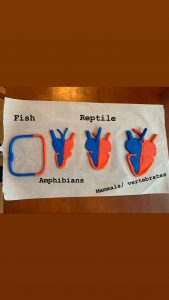The function of the heart is extremely fascinating, but what is also fascinating is how many different shapes it has taken throughout evolution to get us to our human heart of 4 chambers. For my project, I did a clay model of the 4, very, basic steps that the heart has taken over the last 520 million years. The most basic structure of a circulatory system comes from fish and invertebrates, some of which don’t even have blood, but simply fluid that circulates to move nutrients. Those that do have blood flow through the body through one single pump. What was discovered, as the complexity and size of an animal grew, so did the nature of the circulatory organ. Amphibians came with a simple two-chambered heart, one deoxygenated blood and one for oxygenated blood. These two don’t yet have a formal atrium or ventricle. Reptiles came next, they developed what is considered a 2 and ½ chamber, where we see the beginnings of a separation between the atriums, and ventricles and a more complex transport line for blood flowing into and out of the oxygenated and deoxygenated halves. Our four-chambered heart, which is by no means the only model (look at an octopus) came as a way for very large and complex creatures to manage blood pressure throughout the whole system. 4 chambers, plus arteries and veins to transport the blood, which is rich in nutrients for the whole body.


For this Steam Project I had the pleasure of reviewing Kaitlyn Gudmunson. The project that she has done her work on and developed turned out incredibly creative, with good insight on imagery usage in terms of giving the viewer a better understanding of the topic of her project: “Evolution Of The Heartâ€. This project was very clear cut in examining the overall workings of the heart, and the incredible changes that have evolved over time to develop into what we have now; a human heart with four chambers. For Kaitlyn’s project, she made a clay model design that specified the four different biological changes that the heart has gone through to develop into the four chambered heart. I enjoyed her creativity and I also am a visual learner so being able to see something in the form of a diagram was wonderful.
Starting with the fish and invertebrates, they have a circulation system that moves nutrients throughout their body (in those that do not have blood), or the blood flows directly through the body with one pump (in those that do have blood). Like Kaitlyn states, as size in life form started to grow in size, the heart had to prepare and evolve to manage a larger circulatory organ to sustain a bigger system. The heart then in amphibians grew to become a 2 chambered heart for oxygenated blood as well as deoxygenated blood, but no atrium or ventricle has formed yet. Reptiles then became the next life form to have a two and a half chambered heart. This starts a separation of atriums, ventricles, as well as begins the formation of a bigger transport line for blood. This allows for more blood to flow inward and outward. Next, the four chambered heart developed with four chambers, arteries, and veins.
This project was great to read and look at. It gave me an overall better understanding of the evolution of the heart. In Kaitlyn’s presentation of the heart’s evolution, she explained that although it seems complicated, it truly is not; that is why her diagram is so helpful, it really gave a clear cut picture representation of what this evolution looks like.